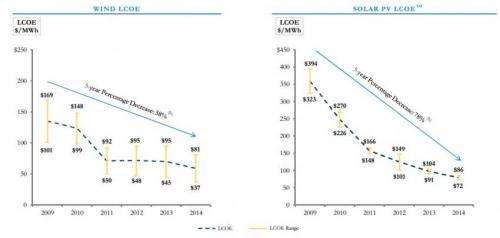November 25, 2014 weblog
Lazard's numbers show cost-competitive gains for wind, solar

Critics wanting to curb the enthusiasm of supporters of alternative energy have held up production cost as proof that coal and natural gas cannot be rivaled. Now there is a sign that the story changed. Diane Cardwell, reporter covering energy for The New York Times, said that solar and wind energy are starting to win on price versus conventional fuels.
Cardwell pointed to a study from the financial advisory and asset management firm Lazard, and she said that "the cost of utility-scale solar energy is as low as 5.6 cents a kilowatt-hour, and wind is as low as 1.4 cents. In comparison, natural gas comes at 6.1 cents a kilowatt-hour on the low end and coal at 6.6 cents. Without subsidies, the firm's analysis shows, solar costs about 7.2 cents a kilowatt-hour at the low end, with wind at 3.7 cents." The Financial Times headlined in September that "US solar and wind start to outshine gas," where Ed Crooks, also referring to the Lazard study, said large wind farms and solar plants were now cost-competitive with gas-fired power in many parts of the United States —-even without subsidy. "We used to say some day solar and wind power would be competitive with conventional generation," George Bilicic, global head of power, energy and infrastructure at Lazard, told the Financial Times. "Well, now it is some day."
Over the last five years, the cost of electricity from wind and solar power plants has gone down to the point where in some markets the price is cheaper than for coal and natural gas, said the New York Times. Yes, but how much of a role did subsidies play in this price picture? Cardwell said "prices were made possible by generous subsidies that could soon diminish or expire, but recent analyses show that even without those subsidies, alternative energies can often compete with traditional sources." Lazard issued its study findings earlier this year, in "Lazard's levelized cost of energy analysis Version 8.0," in September. "We find that Alternative Energy technologies are complementary to conventional generation technologies, and believe that their use will be increasingly prevalent for a variety of reasons, including RPS requirements, carbon regulations, continually improving economics as underlying technologies improve and production volumes increase, and government subsidies in certain regions."
The Lazard study also noted that "Over the last five years, wind and solar PV have become increasingly cost-competitive with conventional generation technologies, on an unsubsidized basis, in light of material declines in the pricing of system components (e.g., panels, inverters, racking, turbines, etc.), and dramatic improvements in efficiency, among other factors."
However, cost has not been the only argument showing the weak side of renewables; there is another factor: "You can't dispatch it when you want to," said Khalil Shalabi, vice president for energy market operations and resource planning at Austin Energy, who was quoted in Cardwell's New York Times report. She said the utility, like others, "still sees value in combined-cycle gas plants, even though they may cost more."
More information: — www.lazard.com/insights
— www.lazard.com/PDF/Levelized%20Cost%20of%20Energy%20-%20Version%208.0.pdf
© 2014 Tech Xplore

















